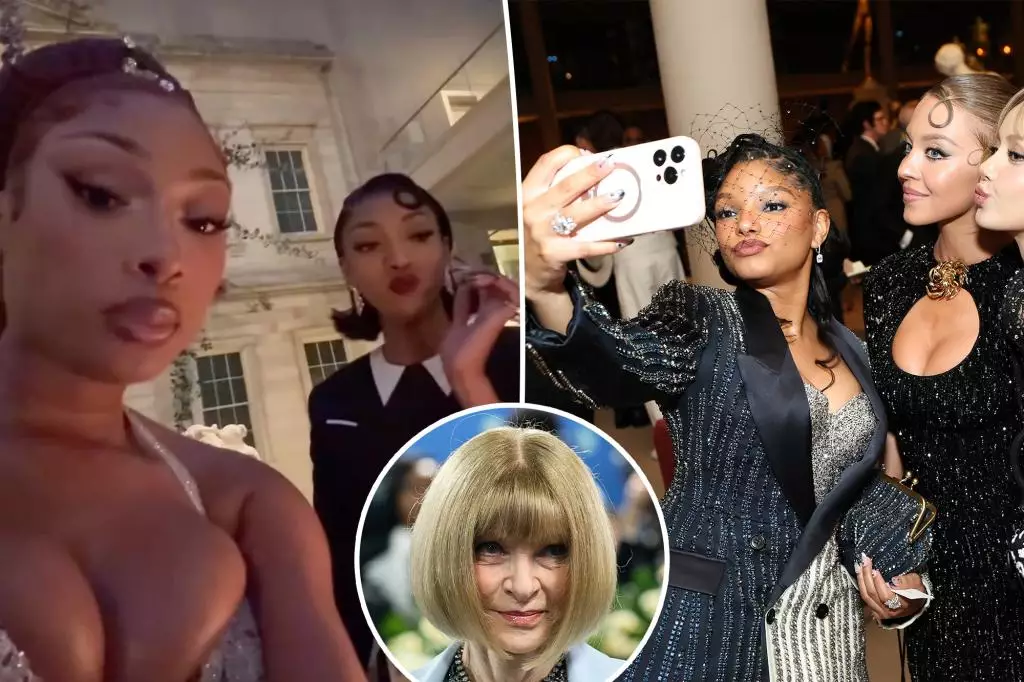The 2025 Met Gala was nothing short of exhilarating, captivating fashion enthusiasts and social media users alike with its glittering displays of creativity and style. However, this year, a few daring celebrities decided to push the boundaries by flaunting their disdain for Anna Wintour’s notorious no-phone rule. This audacious move sparked a mixture of admiration and criticism in an environment where rules are typically sacred. This event’s chaotic energy was heightened as stars like Megan Thee Stallion, Halle Bailey, and Questlove captured moments usually reserved for the voyeuristic gaze of privileged insiders.
The Reality of Celebrity Culture
The decision to disregard the no-phones policy raises intriguing questions about the relationship between celebrities and their fans. In an era dominated by digital interactions, celebrities, in many ways, depend on social media to maintain their public personas. However, by showcasing their behind-the-scenes experiences — in direct defiance of the event’s rules — they challenge the traditional boundaries that separate them from their admirers. While this rebellion might seem like a harmless act of fun, it symbolizes a growing trend of celebrity entitlement that some may find troubling.
Megan Thee Stallion, embodying confidence and charisma, threw caution to the wind by proudly documenting her night. Candid moments featuring fellow stars, sumptuous food, and enchanting decor saturate her social media feed. While her approach reflects an admirable sense of authenticity and connection, it simultaneously represents a concerning flouting of boundaries established by event organizers.
Social Responsibilities and Artistic Integrity
Anna Wintour’s stringent guidelines aim to maintain the mystique of the Met Gala, positioning it as an exclusive enclave of high fashion. For years, it has been a carefully orchestrated event where guests could mingle, enjoy art, and draw attention to their self-expression without the invasion of cameras. The erosion of this exclusivity could signal a shift towards an era where social validation becomes paramount, perhaps compromising the artistic integrity that such events strive to uphold.
The irony here is palpable; while the Met Gala serves to showcase cutting-edge fashion and celebrate artistic expression, the act of broadcasting this intimacy contradicts the very spirit of the event. This paradox reveals a tension between the concepts of celebrity glamour and the privacy that high-fashion events ideally cherish.
The Risks of Rebellion
Historically, stars aware of Wintour’s strict policies have opted for discretion, understanding that disobedience may lead to ramifications, including tarnished reputations and exclusion from future events. Yet, the recent display of rebelliousness has been received with mixed reactions. Is the allure of immediate recognition more crucial than maintaining the integrity of a revered tradition? The risks taken by artists and influencers, while thrilling, open the door to questions about long-term ramifications for their careers and their relationship with the industry.
Questlove, another bold participant of the moment, attempted to sidestep bylaws subtly, opting for clandestine selfies with his fellow celebrities. His casual attitude toward this breach reveals a relatable human desire: to share joyous experiences with friends and fans alike. However, one cannot ignore the resultant ripple effect of such actions on present and future gala attendees. Will adherence to the traditional template become an artifact of the past as celebrities increasingly prioritize social media engagement over timeless elegance?
Shaping Tomorrow’s Gala
As we look ahead, this year’s instances of rule-breaking may signal a changing tide in how high-profile events will be curated and perceived. Institutions like the Met Gala could either adapt to this new digital culture or enforce stricter regulations to maintain the allure of exclusivity. It is crucial for such celebrated events to consider their legacy and their place within an ever-evolving entertainment landscape.
In this dynamic interplay of celebrity, fashion, and social media, one thing remains clear: the necessity for balance is critical. As artists embrace new ways to connect with their audiences, they might unintentionally unravel the rituals that define their world. Embracing the modern landscape is vital, yet doing so responsibly could be the key to preserving the integrity of fashion’s biggest night.

